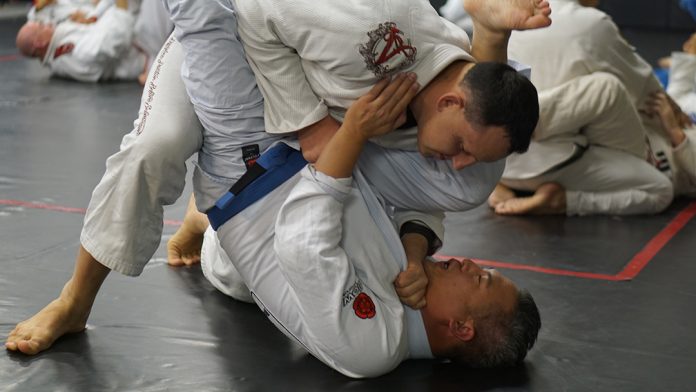
There are many ways you can pass the guard in BJJ. You could do it standing up, half kneeling or even kneeling. You may choose to take the aggressive approach with speed or go slowly and methodically applying pressure. All of these approaches have their merits in BJJ. However, most people tend to find they’re stele in one of them, only utilizing the others occasionally. This holds true for guard passing techniques as well. A good guard pass tends to remove space between you and your opponent before breaking the structure of their guard and passing the legs. One great way to do so is to fold your opponent in half. The best tool to do so is a pressure guard pass known as the stack pass.
The stack guard pass is one of the staples of pressure passing in BJJ. This guard pass has been proven to work at every level of competition grappling martial arts have to offer. Pressure passing is arguably the most uncomfortable way to pass someone’s guard (for the bottom person, at least). The stack pass brings this to a whole different level, causing the opponent to bear both your and his weight. It is a surefire way of passing that has subtle nuances to it.
Tricks For Passing The DDreaded Worm Guard: https://bjj-world.com/worm-guard-pass/
Deconstructing The Stack Guard Pass
The sense of being able to control someone and make it uncomfortable is somewhat sadistic. It is, however, a feeling unlike anything else. The stack pass allows you to feel and do just that when performed correctly.This pass works well when you open the guard of an opponent. Standing passing, and/or knee slice pass is the best places to start from. That said, the stack guard pass is not limited to just these two starting positions. Once you get the knack for it, you’ll be able to transition into it against every guard variation.
When your opponent is in open guard, place both hands under their legs at the same time. The goal is to place both legs on your shoulder. If you keep them on your arms, you’ll find it hard to control the legs, meaning you won’t be able to pass. In order to get your opponent’s legs on your shoulders, you may have to get really low. This may even mean you get your chin down to the mats, for a short while. Your face may, in fact, have to be right at your opponent’s crotch.
Next, make a gable grip with your hands around both of your opponent’s legs. Keep your elbows tight against your opponent. To create pressure you have to get on your toes, lift your knees off the ground, and drive your head forward. When your opponent’s hips are off the ground, place your knees under their hips and sit back down on your feet.
Grip your opponent’s collar on one side (or shoulder in No-Gi) so that your forearm is across their throat. The other hand grips the belt or top of his pants and lifts up. Staying on your toes, thrust your hips and chest to complete the guard pass.
Variations Of The Stack Pass
If you look at stacking, the only “innovation” lately has been around what happens after you get the opponent on their shoulders. The “traditional” thing is pinning the arm with a knee and throwing the legs aside. New “moves” include leg dragging or spinning upside down to take the back. A lot of these moves look great and sometimes work. Ultimately, if you can get someone on their shoulders, lots of stuff can become high percentage.
Murilo Santana has modified “traditional” BJJ to turn the humble stack into a lethal weapon. His simple innovations change the whole complexion of stacking. First of all, Murilo starts on his feet. After walking in he keeps his head tucked in, either pinning the head or the hip of his opponent.
The immediate problem with the stack guard pass, getting someone on their shoulders, is dealt with. With all weight pressing down, the guard play is immediately working against gravity. Compare this to starting on your knees and trying to pull someone on to your knees or just up in general, where you are the one working against gravity.
This variation is something that can be successfully used against people who are known for being ridiculously flexible. When you’re unable to stack your opponent fully, a simple trick is to dip to the side and “burry” your head to the chest, bypassing the flexible legs problem.
What To Do After You Pass
One thing you can do is kip the pass and go directly to the back. These are advanced techniques and require significant drilling to master. Back takes from the stack guard pass are a part of a much larger game and are not intended for everyone.
The stack pass is an uncomfortable position if you’re on the receiving end, which results with errors being made or positions being given in order to relieve some of the pressure. These reactions are exactly the ones that the passer looks for when setting up submissions off of the pass.
Going forward, these cool and very effective arm locks are always there for the taking. When your opponent is defending the stack pass they open up these submission opportunities for yourself.
Getting someone on their shoulders and trapping them there is the fundamental problem. This issue has to be addressed correctly when performing this pass. Actually, this needs to be the primary focus when learning the stack pass. Leave inventing flashy “finishes” for late, when you’ve actually passed. That way you’ll know exactly what you’re doing. Remember that simplicity is key to a successful Jiu-Jitsu game.
This is one of the reasons why stacking gets a bad reputation is when we see is a bigger/stronger passer bullying a defensive guard player. Smaller grapplers should avoid getting caught on their shoulders during “balling up”. Apart from the submission threats off the stack pass, gruesome injuries are possible as well.
If you’re about pressure passing or you want to focus on that type of BJJ Gameplay you should consider learning from Bernardo Faria. Bernardo, 5x World Champion is the worlds most proven pressure passer. The good thing about Bernardo Faria’s DVD and Digital Instructionals is that you don’t have to be young, strong and flexible. All you have to know is the right technique and you will be able to apply it in any circumstances and against any opponent. Check out Bernardo Faria DVD Battle Tested Pressure Passing and the List Of Techniques. There are tons of techniques involved in this product and you can’t go wrong with it.


![Darce Choke Encyclopedia – Origins, Mechanics and Variations [2025] BJJ, choke, Brabo, BJJ Darce Choke, D'arce Choke, Darce BJJ Choke](https://bjj-world.com/wp-content/uploads/2017/11/JungPoirierLeeYahoo-218x150.jpg)










![Get Off My Legs Gringo Craig Jones DVD Review [2025] Get Off My Legs Gringo Craig Jones DVD Review](https://bjj-world.com/wp-content/uploads/2025/03/get-off-my-legs-gringo-craig-jones-dvd-review-218x150.png)

![Leg Lock Entries Helena Crevar DVD Review [2025] Leg Lock Entries Helena Crevar DVD Review](https://bjj-world.com/wp-content/uploads/2025/03/leg-lock-entries-helena-crevar-dvd-review-218x150.png)
![Special K Guard Neil Melanson DVD Review [2025] Special K Guard Neil Melanson DVD Review](https://bjj-world.com/wp-content/uploads/2025/03/special-k-guard-neil-melanson-dvd-review-218x150.png)
![Arm Bar It All Shawn Melanson DVD Review [2025] Arm Bar It All Shawn Melanson DVD Review](https://bjj-world.com/wp-content/uploads/2025/03/arm-bar-it-all-shawn-melanson-dvd-review-218x150.png)

![Flow Pressure Kauan Barboza DVD Review [2025] Flow Pressure Kauan Barboza DVD Review](https://bjj-world.com/wp-content/uploads/2025/02/flow-pressure-kauan-barboza-dvd-review-324x235.png)

![Spider and Lasso Guard Jared Welman DVD Review [2025] Spider and Lasso Guard Jared Welman DVD Review](https://bjj-world.com/wp-content/uploads/2025/01/spider-and-lasso-guard-jared-welman-dvd-review-100x70.png)

![Reverse Arm Bar System Andrew Kerfoot DVD Review [2024] Reverse Arm Bar System Andrew Kerfoot DVD Review](https://bjj-world.com/wp-content/uploads/2024/10/reverse-arm-bar-system-andrew-kerfoot-dvd-review-100x70.png)

![Back Hacks Yigit Haney BJJ DVD Review [2025] Back Hacks Yigit Haney BJJ DVD Review](https://bjj-world.com/wp-content/uploads/2024/12/back-hacks-yigit-haney-bjj-dvd-review-100x70.png)



![Leg Lock Entries Helena Crevar DVD Review [2025] Leg Lock Entries Helena Crevar DVD Review](https://bjj-world.com/wp-content/uploads/2025/03/leg-lock-entries-helena-crevar-dvd-review-100x70.png)
![Dynamic De La Riva Guard Otavio Sousa DVD Review [2025] Dynamic De La Riva Guard Otavio Sousa DVD Review](https://bjj-world.com/wp-content/uploads/2025/02/dynamic-de-la-riva-guard-otavio-sousa-dvd-review-100x70.png)





![Ginastica Natural Alvaro Romano DVD Review [2024] Ginastica Natural Alvaro Romano DVD Review](https://bjj-world.com/wp-content/uploads/2024/12/ginastica-natural-alvaro-romano-dvd-review-100x70.png)
![EMU Guard 2.0 Benjamin Power DVD Review [2024] EMU Guard 2.0 Benjamin Power DVD Review](https://bjj-world.com/wp-content/uploads/2024/11/emu-guard-2-0-benjamin-power-dvd-review-100x70.png)


![BJJ Foundations Mikey Musumeci DVD Bundle Review [2024] BJJ Foundations Mikey Musumeci DVD Bundle Review](https://bjj-world.com/wp-content/uploads/2024/09/bjj-foundations-mikey-musumeci-dvd-bundle-review-100x70.png)


![Charles Allan Price Building Workouts For BJJ DVD Review [2024] Charles Allan Price Building Workouts For BJJ DVD Review](https://bjj-world.com/wp-content/uploads/2024/09/charles-allan-price-building-workouts-for-bjj-review-100x70.png)
![Reverse Armlock Magid Hage DVD Review [2024] Reverse Armlock Magid Hage DVD Review](https://bjj-world.com/wp-content/uploads/2024/12/reverse-armlock-magid-hage-dvd-review-100x70.png)
![Creating Back Exposure Luke Griffith DVD Review [2025] Creating Back Exposure Luke Griffith DVD Review](https://bjj-world.com/wp-content/uploads/2025/01/creating-back-exposure-luke-griffith-dvd-review-100x70.png)
